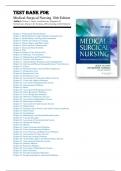Exam (elaborations)
Test Bank for Medical-Surgical Nursing 10th Edition By Lewis, Bucher, Heitkemper, Harding, Kwong, Roberts Chapter 1-68
Test Bank for Medical-Surgical Nursing 10th Edition By Lewis, Bucher, Heitkemper, Harding, Kwong, Roberts Chapter 1-68
[Show more]




